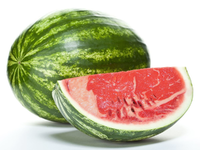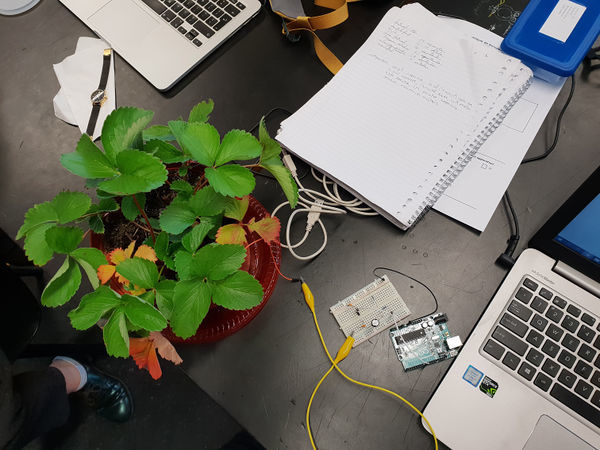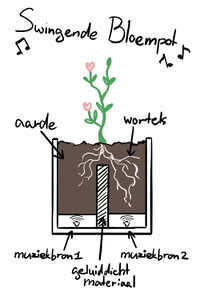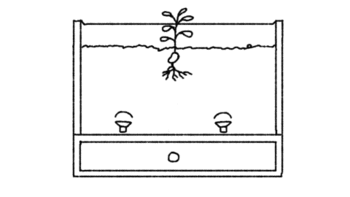User:0911497
Contents
INFO
Karlijn den Hoedt
0911497
Graphic design
projects I have worked on
Digital Craft 2018: Cybernetics
PROJECT 1
For our first assessment I formed a group with Annemarie (animation), Dieke (animation), Koen (animation) and Lot (graphic design). We received a couple of cards from the teachers for this project. There where three types of cards from which you had to choose one of each kind to reimagine a certain question, technology and platform.
07/09/18
We started this day playing with the cards to see what kind of interesting combinations we could make and what we could think of with this combination. After a while we settled with the idea of making an object designed for a tree to use. we all found it quit funny and weird which made it the perfect first project of this quarter. After thinking out loud which possible combinations a tree could use we finally ended up with:
"Make an object designed for a tree to use 'Social Networking'. Use folded paper to create a physical model of this new thing."
We just thought that this would be a funny thing to do, but the problem is that a tree does not give that much input to the world around him. One of the things I thought of was that the tree could many write comments with its twigs. But we came to the conclusion that the wind was the one doing it in the end. So we decided to keep it to just 'Yes' and 'No' decisions to keep it simple. This is how we arrived at Tinder, because not only is the idea of a tree on Tinder pretty funny, but it's also simple to use. You merely need to swipe to the left or the right whether you want to date a certain person or not. Maybe we could let the tree decide by letting it grow to either the left or the right...
For this prototype we decided to use a smaller plant instead of a tree, because it's much easier for a smaller plant to grow and to build an object for it. Our plan is to let the plant grow in a tube-like structure and let it decide to grow further in either the left tube or the right tube. In both tubes there is a sensor that detects whether it should swipe either left or right respectively. As of now we haven't figured out how to make the object swipe just yet. Today we made a prototype of the tube system out of paper, with one of the tube ways already being taken by the plant just to show what it would look like. We also made a Facebook and Tinder account for our plant: Clovis Clematis.
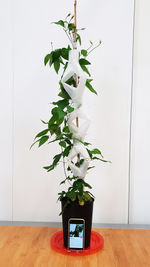
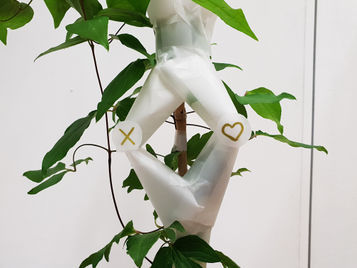
photos by: Lot
13/09/18
For today we had to present Clovis and her cyborg appendage to the rest of the class. The reception was pretty okay. The main question that was brought up was 'How can a plant know that it is using Tinder?' Obviously it doesn't, but maybe we can convert the Tinder profile picture into sound and give the plant a choice instead of letting it grow by chance.In two weeks we need to have a prototype that works as much as possible. It doesn't have to be a continuation of project 1, but it does need:
-to be somewhat related to these explorations on reimagining technology.
-to be 3D, a real thing.
-to be simulating interactive feedback loops.
PROJECT 2
14/09/18 - Today we were trying to figure out what our next project should be about. As we were in the mindset of plants with our previous project. First we thought about a concept relating to the habitat of trees and that affects their lifespan. For example trees in the city grow faster than trees in the forest, due to the amount of CO2 in the air around them, but they also have shorter lifespans. We thought about adding a meter to a tree for it to know the amount of CO2 around him, but it wouldn't really add some sort of feedback loop so we scrapped it. There was also the idea that we could use CO2 as a building material. But the idea that we were most excited about was about a plant that grows meat instead fruit. This could be an alternative to meat from animals.
17/09/18 - We decided to keep the project a bit more realistic and to focus back on plants making decisions. The idea was to bring the decision making more to the plants this time and present them two different kinds of music. We know that plants can detect vibrations, we want to know if they have a preference. We're also planning some experiments to see what kind of effects music has on plants. What's interesting as well is a way to record where you're touching the plant: https://www.youtube.com/watch?v=EcRSKEIucjk
We are going to do our own experiments to see how music affects plants. For my experiment, I 3D modeled a special plantpot, but was too late to 3D print it on the same day.
18/09/18 - I started planting my first test plants to look if the plants react to music vibrations from above instead of on the roots .
20/09/18 - Today we tried getting a reaction from the plant by touching it, like in the video of "BOTANICUS INTERACTICUS". The technology they used to do this is called Touché and we tried to replicate it with Arduino, like Nick Arner did here: https://www.youtube.com/watch?v=ZPsU6U54CRM We got pretty far with the help of Javier, but eventually we found out that for this experiment to work, Arduino needs to be communicating with a different program we didn't have. So we couldn't continue.
Javier did connect us with some very interesting and useful sites:
https://github.com/damellis/ESP/wiki/%5BExample%5D-Touch%C3%A9-swept-frequency-capacitive-sensing
https://www.bright.nl/nieuws/artikel/4034676/disney-maakt-elke-plant-aanraakgevoelig
https://www.nickarner.com/blog/2017/7/8/talking-to-plants-touch%C3%A9-experiments
After that we looked back at our Clovis experiment, trying to find a different way of making plants react to and decide their music. We thought of a way to create a feedback loop in which the plant is searching for his favorite tracks. The pot is seperated in two halves and each halve has a speaker playing its own distinct music. A bean/seed is placed above the seperation, allowing it to grow to both sides. Using some kind of transparent soil, a webcam and MAX7, we are able to distinguish the difference in color between the two halves. Roots have some kind of white color, so if one side contains more white than the other, we assume that the plant prefers the music on the whiter side more. Therefore, the music on the part with the most roots will keep playing and the music on the other side will switch.
21/09/18 - We got together and made a list of things we need to do for next Thursday. We'll need to build a box for the plant, transparent soil to see the roots, a webcam to record the amount of white color in the transparent soil and the code to recognize the change in whiteness and to switch music tracks if necessary. We made the design for the box today as well as the majority of the code needed to build this prototype.
26/09/18 - This time we were preparing for next day's presentation, deciding who should talk about what. Karlijn and Lot were working on a powerpoint, Annemarie and me worked on some drawings and animations to show during the presentation and Dieke had finished the box.
Drawing left: Annemarie | Animation right: Koen
